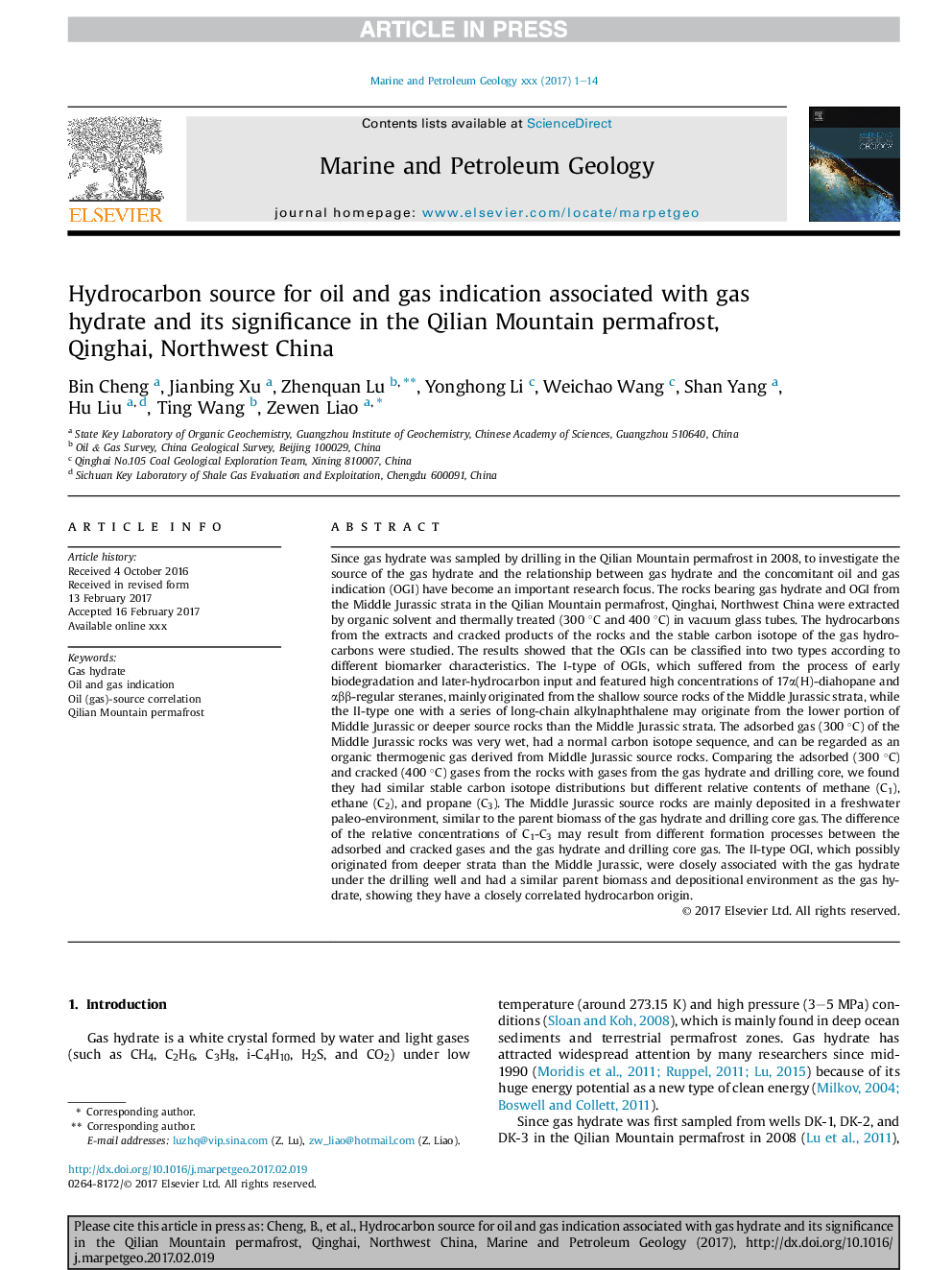| کد مقاله | کد نشریه | سال انتشار | مقاله انگلیسی | نسخه تمام متن |
|---|---|---|---|---|
| 8909312 | 1637138 | 2018 | 14 صفحه PDF | دانلود رایگان |
عنوان انگلیسی مقاله ISI
Hydrocarbon source for oil and gas indication associated with gas hydrate and its significance in the Qilian Mountain permafrost, Qinghai, Northwest China
ترجمه فارسی عنوان
منبع هیدروکربنی برای نشان دادن نفت و گاز مرتبط با هیدرات گاز و اهمیت آن در قارچ کوهی کیلیان، چینگهای، شمال غربی چین
دانلود مقاله + سفارش ترجمه
دانلود مقاله ISI انگلیسی
رایگان برای ایرانیان
کلمات کلیدی
هیدرات گاز، نشانه نفت و گاز، وابستگی منابع نفتی (گاز)، قارچ کوهستانی قلیان،
موضوعات مرتبط
مهندسی و علوم پایه
علوم زمین و سیارات
زمین شناسی اقتصادی
چکیده انگلیسی
Since gas hydrate was sampled by drilling in the Qilian Mountain permafrost in 2008, to investigate the source of the gas hydrate and the relationship between gas hydrate and the concomitant oil and gas indication (OGI) have become an important research focus. The rocks bearing gas hydrate and OGI from the Middle Jurassic strata in the Qilian Mountain permafrost, Qinghai, Northwest China were extracted by organic solvent and thermally treated (300 °C and 400 °C) in vacuum glass tubes. The hydrocarbons from the extracts and cracked products of the rocks and the stable carbon isotope of the gas hydrocarbons were studied. The results showed that the OGIs can be classified into two types according to different biomarker characteristics. The I-type of OGIs, which suffered from the process of early biodegradation and later-hydrocarbon input and featured high concentrations of 17α(H)-diahopane and αββ-regular steranes, mainly originated from the shallow source rocks of the Middle Jurassic strata, while the II-type one with a series of long-chain alkylnaphthalene may originate from the lower portion of Middle Jurassic or deeper source rocks than the Middle Jurassic strata. The adsorbed gas (300 °C) of the Middle Jurassic rocks was very wet, had a normal carbon isotope sequence, and can be regarded as an organic thermogenic gas derived from Middle Jurassic source rocks. Comparing the adsorbed (300 °C) and cracked (400 °C) gases from the rocks with gases from the gas hydrate and drilling core, we found they had similar stable carbon isotope distributions but different relative contents of methane (C1), ethane (C2), and propane (C3). The Middle Jurassic source rocks are mainly deposited in a freshwater paleo-environment, similar to the parent biomass of the gas hydrate and drilling core gas. The difference of the relative concentrations of C1-C3 may result from different formation processes between the adsorbed and cracked gases and the gas hydrate and drilling core gas. The II-type OGI, which possibly originated from deeper strata than the Middle Jurassic, were closely associated with the gas hydrate under the drilling well and had a similar parent biomass and depositional environment as the gas hydrate, showing they have a closely correlated hydrocarbon origin.
ناشر
Database: Elsevier - ScienceDirect (ساینس دایرکت)
Journal: Marine and Petroleum Geology - Volume 89, Part 1, January 2018, Pages 202-215
Journal: Marine and Petroleum Geology - Volume 89, Part 1, January 2018, Pages 202-215
نویسندگان
Bin Cheng, Jianbing Xu, Zhenquan Lu, Yonghong Li, Weichao Wang, Shan Yang, Hu Liu, Ting Wang, Zewen Liao,
